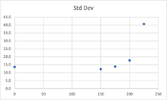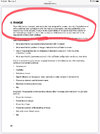JimGnitecki
Member
- Joined
- Mar 28, 2010
- Messages
- 1,258
Any of you shooters who use a Labradar for velocity measurment at both the muzzle AND downrange at different distances:
Is it normal for the standard deviation in the downrange velocities to INCREASE with distance from the muzzle?
I am asking because with my Cowboy Action 357 Magnum rifle and handgun load, the SD stays pretty level at CAS ranges. But with my Pedersoli Sharps replica current handload, the SD increases rather dramatically with distance from the muzzle:

I have noticed that at the 150 meter = 164 yard range that I am currently doing test shooting at, the best 5-shot groups seem unable to get below 1.5 inches (about 0.87 MOA at that distance). I am wondering if this climb in SD is causing that, and if so, what could be causing the climb in SD?
Jim G
Is it normal for the standard deviation in the downrange velocities to INCREASE with distance from the muzzle?
I am asking because with my Cowboy Action 357 Magnum rifle and handgun load, the SD stays pretty level at CAS ranges. But with my Pedersoli Sharps replica current handload, the SD increases rather dramatically with distance from the muzzle:

I have noticed that at the 150 meter = 164 yard range that I am currently doing test shooting at, the best 5-shot groups seem unable to get below 1.5 inches (about 0.87 MOA at that distance). I am wondering if this climb in SD is causing that, and if so, what could be causing the climb in SD?
Jim G


